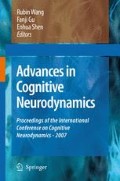Abstract
The MiCRAM project has been developing detailed neural models of the inferior colliculus (IC) as the basis for understanding the neural networks that underlie early auditory processing at that level. The initial phase of this project has been to develop biologically plausible models of the physiologically distinct cell types of the IC. This has led to the recognition that some of the gross behavior that produces delay sensitivity may be the result of detailed dynamic interactions between multiple channels.
Access this chapter
Tax calculation will be finalised at checkout
Purchases are for personal use only
Preview
Unable to display preview. Download preview PDF.
References
Rees, A., et al.: Regularity of Firing of Neurons in the Inferior Colliculus. Journal of Neurophysiology. 77 (1997) 2945–2965.
Wilson, M., et al.: GENESIS, the Caltech Neural Network Simulator. (1991) Available from: ftp://genesis.caltech.edu/
Wiener, M.C. and B.J. Richmond: Decoding Spike Trains Instant by Instant Using Order Statistics and the Mixture-of-Poissons Model. Journal of Neuroscience. 23 (2003) 2394–2406.
Kass, R.E. and V. Ventura: A Spike-Train Probability Model. Neural Computation. 13 (2001) 1713–1720.
Eden, U.T., et al.: Dynamic Analysis of Neural Encoding by Point Process Adaptive Filtering. Neural Computation. 16 (2004) 971–998.
Brown, E.N., et al.: The Time-Rescaling Theorem and Its Application to Neural Spike Train Data Analysis. Neural Computation. 14 (2001) 325–341.
Sivaramakrishnan, S. and D.L. Oliver: Distinct K Currents Result in Physiologically Distinct Cell Types in the Inferior Colliculus of Rat. Journal of Neuroscience. 21 (2001) 2861–2877.
De Schutter, E. and J.M. Bower: An Active Membrane Model of the Cerebellar Purkinje Cell: I. Simulation of Current Clamps in Slice. Journal of Neurophysiology. 71 (1994) 375–400.
Olsen, J.F.: Processing of Biosonar Information by the Medial Geniculate Body of the Mustached Bat, Pteronotus parnelli. Washington University (1986).
Simmons, J.A., et al.: Discrimination of Jittered Sonar Echoes by the Echolocating Bat, Eptesicus fuscus: the Shape of Target Images in Echolocation. Journal of Comparative Physiology A. 167 (1990) 589–616.
Author information
Authors and Affiliations
Editor information
Editors and Affiliations
Rights and permissions
Copyright information
© 2008 Springer-Verlag Berlin Heidelberg
About this paper
Cite this paper
Erwin, H., Elshaw, M., Rees, A., Perez-Gonzalez, D., Wermter, S. (2008). Modeling Neurons of the Inferior Colliculus. In: Wang, R., Shen, E., Gu, F. (eds) Advances in Cognitive Neurodynamics ICCN 2007. Springer, Dordrecht. https://doi.org/10.1007/978-1-4020-8387-7_12
Download citation
DOI: https://doi.org/10.1007/978-1-4020-8387-7_12
Publisher Name: Springer, Dordrecht
Print ISBN: 978-1-4020-8386-0
Online ISBN: 978-1-4020-8387-7
eBook Packages: Biomedical and Life SciencesBiomedical and Life Sciences (R0)

